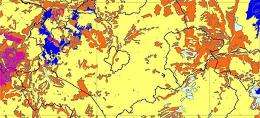Seeing beneath the soil to uncover the past

Archaeology is no longer just about digging holes. New research by a team led from the University of Leeds promises to improve the investigation of our heritage from the air.
The work should revolutionize the use of 'state-of-the-art' remote sensing technology, improving the 'hit rate' of aerial archaeology without physically disturbing sites of cultural heritage.
Over half of the archaeological sites in the UK have been detected using aerial photographs. Heritage experts and researchers use these pictures to find where once obvious walls, tracks, ditches and pits are now buried by studying changes to crop growth or soil color.
However, this technique is difficult to use on heavy, clay-like soils because the dense soil structure makes it far harder to spot signs of the past. Even on well-drained soils, where the technique works best, many details of a settlement's layout will be missed.
The method used by the DART (Detection of Archaeological Residues using remote sensing Techniques) team promises to improve the hit rate from air-borne archaeological exploration, particularly on difficult-to-study soils like clay. The team is using sophisticated sensors - on the ground and in the air - to collect images at many different wavelengths, within and outside the visible spectrum. Once fully analysed, these 'hyper-spectral images' should reveal signs of soil disturbance that would otherwise be invisible.
Dr. Ant Beck, a University of Leeds research fellow and a key member of the Detection of Archaeological Residues using remote sensing Techniques (DART) project said: "Our findings are leading to an improved understanding of detection techniques. In the future, our work will allow successful remote sensing surveys to take place in landscapes where, at present, the physical and environmental factors have been difficult, to say the least. This work will transform archaeology, providing a better view of the archaeological residues under the soil without disturbing, and potentially damaging, sites of specific interest."
Initial work has been taking place in Cambridgeshire this year. Although it is still at an early stage, early analysis has confirmed that the hyperspectral images are revealing more information than standard aerial photographs of the same site.
"These early results are very encouraging," Dr. Beck said. "Further analysis should allow us to pinpoint the links between archaeological features, environmental dynamics and crop type leading to improved detection in, what have traditionally been considered, marginal landscapes."
More information: Follow the progress of the DART project at: dartproject.info/WPBlog/
Provided by University of Leeds















